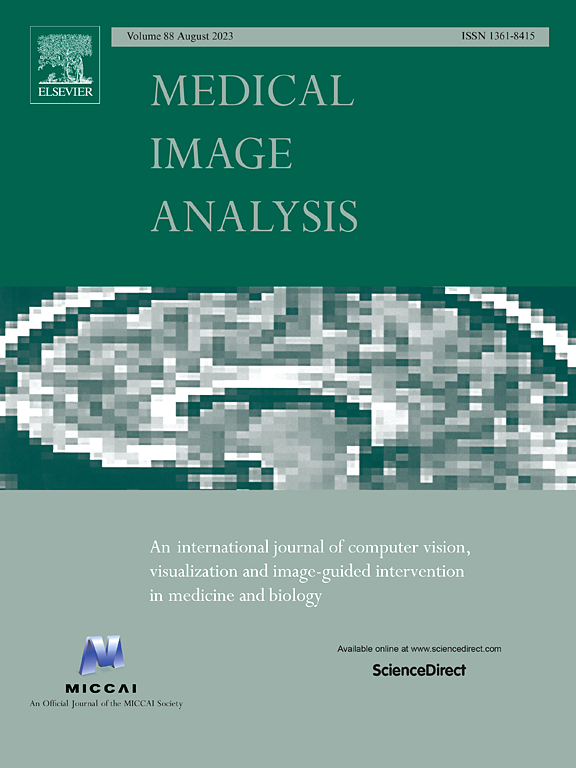MonoPCC: Photometric-invariant cycle constraint for monocular depth estimation of endoscopic images
IF 10.7
1区 医学
Q1 COMPUTER SCIENCE, ARTIFICIAL INTELLIGENCE
引用次数: 0
Abstract
Photometric constraint is indispensable for self-supervised monocular depth estimation. It involves warping a source image onto a target view using estimated depth&pose, and then minimizing the difference between the warped and target images. However, the endoscopic built-in light causes significant brightness fluctuations, and thus makes the photometric constraint unreliable. Previous efforts only mitigate this relying on extra models to calibrate image brightness. In this paper, we propose MonoPCC to address the brightness inconsistency radically by reshaping the photometric constraint into a cycle form. Instead of only warping the source image, MonoPCC constructs a closed loop consisting of two opposite forward–backward warping paths: from target to source and then back to target. Thus, the target image finally receives an image cycle-warped from itself, which naturally makes the constraint invariant to brightness changes. Moreover, MonoPCC transplants the source image’s phase-frequency into the intermediate warped image to avoid structure lost, and also stabilizes the training via an exponential moving average (EMA) strategy to avoid frequent changes in the forward warping. The comprehensive and extensive experimental results on five datasets demonstrate that our proposed MonoPCC shows a great robustness to the brightness inconsistency, and exceeds other state-of-the-arts by reducing the absolute relative error by 7.27%, 9.38%, 9.90% and 3.17% on four endoscopic datasets, respectively; superior results on the outdoor dataset verify the competitiveness of MonoPCC for the natural scenario. Codes are available at https://github.com/adam99goat/MonoPCC.
MonoPCC:用于内窥镜图像的单眼深度估计的光度不变循环约束
在自监督单目深度估计中,光度约束是必不可少的。它包括使用估计的深度和姿态将源图像扭曲到目标视图上,然后最小化扭曲图像和目标图像之间的差异。然而,内窥镜内置光源引起明显的亮度波动,从而使光度约束不可靠。以前的努力只能减轻这种依赖额外的模型来校准图像亮度。在本文中,我们提出MonoPCC从根本上解决亮度不一致的问题,将光度约束重塑为循环形式。MonoPCC不是只对源图像进行扭曲,而是构建了一个由两个相反的向前向后扭曲路径组成的闭环:从目标到源,然后再回到目标。这样,目标图像最终从自身接收到一个扭曲的图像循环,这自然使约束对亮度变化保持不变。此外,MonoPCC将源图像的相位频率移植到中间扭曲图像中以避免结构丢失,并通过指数移动平均(EMA)策略稳定训练以避免前向扭曲的频繁变化。在5个数据集上进行的综合、广泛的实验结果表明,MonoPCC对亮度不一致具有较强的鲁棒性,在4个内镜数据集上的绝对相对误差分别降低了7.27%、9.38%、9.90%和3.17%,优于其他技术水平;在室外数据集上的优异结果验证了MonoPCC在自然场景中的竞争力。代码可在https://github.com/adam99goat/MonoPCC上获得。
本文章由计算机程序翻译,如有差异,请以英文原文为准。
求助全文
约1分钟内获得全文
求助全文
来源期刊

Medical image analysis
工程技术-工程:生物医学
CiteScore
22.10
自引率
6.40%
发文量
309
审稿时长
6.6 months
期刊介绍:
Medical Image Analysis serves as a platform for sharing new research findings in the realm of medical and biological image analysis, with a focus on applications of computer vision, virtual reality, and robotics to biomedical imaging challenges. The journal prioritizes the publication of high-quality, original papers contributing to the fundamental science of processing, analyzing, and utilizing medical and biological images. It welcomes approaches utilizing biomedical image datasets across all spatial scales, from molecular/cellular imaging to tissue/organ imaging.
 求助内容:
求助内容: 应助结果提醒方式:
应助结果提醒方式:


